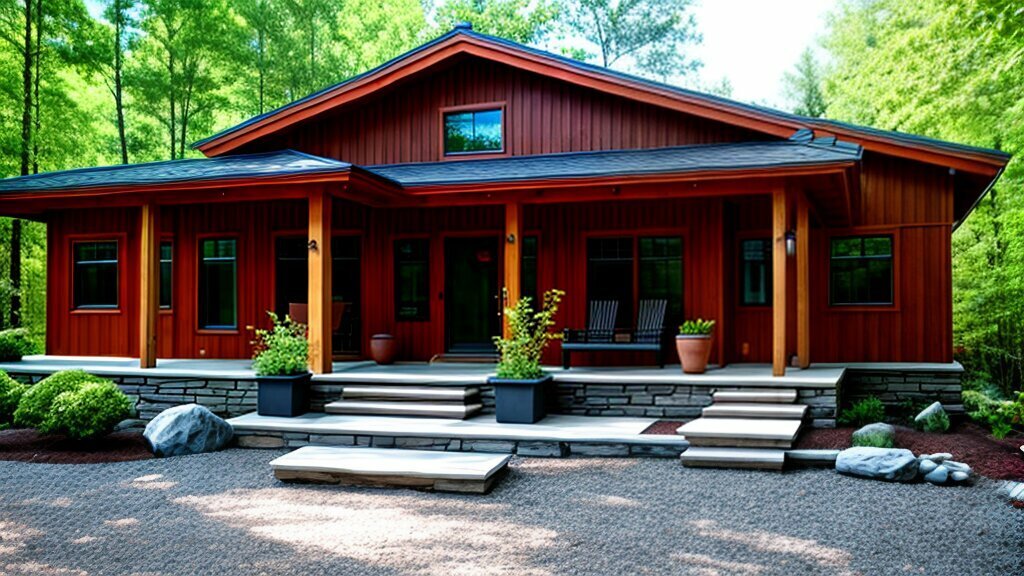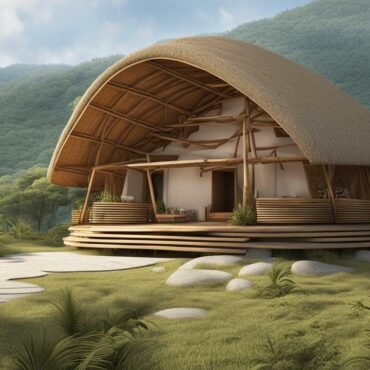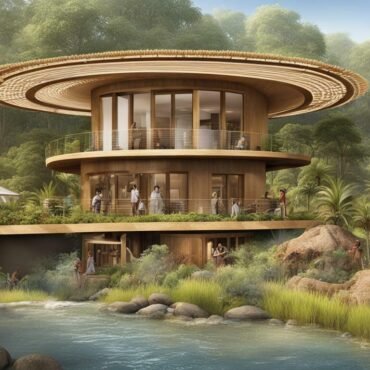When we think of architecture, we typically consider the aesthetic and functional aspects of buildings. However, architecture is more than just the physical structure. It tells a story about the culture and identity of the people who designed and built it. The interplay between cultural identity and the built environment is an essential element in shaping societies and preserving cultural heritage.
The built environment reflects the cultural values, beliefs and practices of a community. Throughout history, architecture has been used to create a sense of place and belonging for individuals and communities. It has played a crucial role in shaping our collective identity and history.
Key Takeaways:
- Cultural identity and the built environment are interconnected.
- Indigenous architecture plays a vital role in shaping societies and preserving cultural heritage.
- The design and construction of buildings reflect the cultural values, beliefs and practices of a community.
The Impact of Cultural Identity on Architectural Heritage
Architecture is not merely a functional necessity; it also reflects the socio-cultural identity of a community. Cultural identity, which encompasses traditions, customs, beliefs, and values, influences an array of social practices, including the design and construction of buildings.
Architectural heritage, the physical manifestation of cultural identity, is a vital aspect of our built environment. It preserves a community’s history, traditions, and values while also providing a sense of belonging and continuity. The significance of architectural heritage cannot be overstated, as it is a powerful means of communicating cultural identity to future generations.
Architectural heritage is integral to shaping a community’s identity. It captures the essence of cultural heritage in the form of buildings, monuments, and public spaces, and serves as a reflection of a community’s collective memory. The preservation of architectural heritage is therefore essential in sustaining cultural continuity and fostering community pride.
Historical Buildings and Community Identity
Historical buildings are an integral part of architectural heritage, as they embody a community’s social and cultural identity. They serve as tangible artefacts of a community’s history, representing both its achievements and its struggles. For instance, one of the most iconic historical buildings in the UK, the Houses of Parliament, is a symbol of the country’s political and social identity, and a testament to its rich cultural heritage.
Historical buildings are also frequently used as community spaces, serving as a hub for social events and cultural celebrations. As such, they play a vital role in fostering a sense of community and belonging. The preservation of historical buildings is therefore critical in sustaining a community’s cultural practices and traditions.
Challenges in Preserving Architectural Heritage
Despite the importance of preserving architectural heritage, there are many challenges to doing so. One fundamental issue is the lack of resources dedicated to heritage preservation. Many heritage buildings are in urgent need of restoration, but there is often limited funding available to carry out these projects.
Another challenge is the threat of urban development and modernisation. As cities grow, there is often immense pressure to prioritise new building projects over the preservation of historical buildings. This can lead to the loss of significant cultural landmarks, resulting in the erosion of a community’s cultural identity.
Furthermore, the preservation of architectural heritage must also navigate the tensions between tradition and modernity. The desire to maintain cultural traditions and values must be balanced with the need for change and evolution in the built environment.
The Benefits of Preserving Architectural Heritage
Despite the challenges, the preservation of architectural heritage offers many benefits. For one, it is an effective means of promoting community pride and strengthening a community’s sense of identity. Historical buildings and landmarks serve as tangible links to a community’s past, creating a sense of continuity and shared history.
Architectural heritage also has the potential to attract tourism, generating economic opportunities for local communities. Many historical buildings have cultural significance, not only to local communities but to the wider public, and can serve as attractions for visitors interested in understanding the country’s history and culture.
Finally, preserving architectural heritage is an act of cultural preservation and respect. It acknowledges the value of a community’s history and traditions and demonstrates a commitment to preserving them for future generations.

Cultural Landscapes: Capturing Identity in the Physical Environment
As we have explored, cultural identity is closely tied to the built environment, but it goes beyond individual buildings. Cultural landscapes encompass the broader physical environment, including natural and human-made features, that embody the cultural traditions and beliefs of a community.
These landscapes can take many forms, from rural agricultural landscapes to urban neighbourhoods, and they reflect the ways in which people interact with and shape the environment around them. For Indigenous communities, cultural landscapes are particularly significant as they represent a tangible connection to their ancestral lands and traditions.
It is through these landscapes that Indigenous peoples can express their cultural identity and maintain their connection to their heritage.

These landscapes are not only important for cultural preservation, they also contribute to a community’s social identity and sense of place. The physical environment can influence social practices and foster a sense of belonging, reinforcing cultural identity and community ties.
“The landscape we see around us, whether natural or built, influences the way we interact with each other and shapes our sense of community.”
In the next section, we will explore the importance of community engagement in creating and maintaining cultural landscapes.
Community Engagement and Sense of Place in Built Environments
Engagement with local communities is crucial in the design and development of built environments. When community members are involved in urban development projects, they are more likely to feel a sense of ownership and pride in their surroundings. This connection to the built environment can foster a stronger sense of place and enhance cultural identity.
One example of successful community engagement in urban development is the “10-Minute Neighborhoods” project in Portland, Oregon. This initiative involves residents in the planning of their neighbourhoods, ensuring that essential amenities such as grocery stores, parks and schools are within a ten-minute walk of every home. This approach has been successful in creating livable, walkable neighbourhoods that promote community interaction and foster a sense of place.

Successful community engagement can also help to preserve cultural identity. When local communities are involved in the preservation of historic landmarks and buildings, they are more likely to have a vested interest in their upkeep and maintenance. This sense of ownership can lead to a greater appreciation and understanding of the cultural traditions and values associated with these structures.
Moreover, engaging with diverse communities allows for a more inclusive approach to urban development. When people from all walks of life are involved in the planning process, their unique perspectives and needs can be taken into account. This can lead to more culturally responsive design that reflects the needs and values of the community.
Ultimately, community engagement is crucial in the creation of built environments that promote a sense of place and cultural identity. By involving local communities in the planning and development process, we can create spaces that are not only functional and aesthetically pleasing but also reflect the cultural identities and values of the people who call them home.
Historical Preservation: Sustaining Cultural Identity through Architecture
Historical preservation is an essential component of cultural identity. It serves as a tangible reminder of a community’s past, present, and future. By preserving architectural heritage, we can connect with the traditions and values of our ancestors, and keep them alive for future generations.
However, historical preservation comes with its own set of challenges. As cities modernize and evolve, buildings that once stood as symbols of cultural identity may no longer be practical or financially viable. In some cases, the cost of upkeep and repair may outweigh the value of the building itself, leading to its eventual demolition.
Despite these challenges, the benefits of historical preservation far outweigh the costs. Preserving the architecture of the past not only maintains cultural traditions but also serves as a reminder of the resilience and strength of a community. It tells the story of how a people came to be and the challenges they have overcome.
Preservation efforts can also contribute to the development of tourism, as visitors are often drawn to the unique architecture of a place. This, in turn, can boost the local economy and provide opportunities for community engagement and cultural exchange.
Overall, historical preservation is crucial in sustaining a community’s cultural identity. By preserving architectural heritage, we can maintain a connection to our ancestors while continuing to shape our cultural identity for the future.

“Preservation of one’s own culture does not require contempt or disrespect for other cultures.” – Cesar Chavez
Cultural Identity and Built Environment
After exploring the impact of cultural identity on architectural heritage, cultural landscapes, community engagement, and historical preservation, it is clear that the built environment plays a crucial role in preserving cultural identity. The interplay between cultural identity and the built environment is essential in shaping societies and preserving cultural heritage.
Appreciate and Protect Diverse Architectural Expressions
As we move towards a more globalized world, it is essential to embrace and appreciate the diverse architectural expressions that contribute to our cultural identities. We must protect and preserve our architectural heritage as a means of maintaining cultural traditions and values. By involving communities in the design and development of built environments, we can enhance their sense of place and strengthen cultural connections.
In conclusion, Indigenous architecture has played a significant role in preserving cultural heritage and identity. It is crucial for us to understand the complexity of cultural identity and its relationship with the built environment. By doing so, we can create built environments that reflect and preserve our cultural identities for future generations.
FAQ
Q: What is the relationship between cultural identity and the built environment?
A: Cultural identity is closely intertwined with the built environment as it influences the design and construction of buildings and structures. The built environment serves as a physical representation of a community’s history, values, and traditions.
Q: How does cultural identity impact architectural heritage?
A: Cultural identity plays a crucial role in shaping architectural heritage. It influences the design choices, materials used, and construction techniques employed, resulting in unique and distinct architectural expressions that reflect a community’s cultural identity.
Q: What are cultural landscapes, and how do they capture identity in the physical environment?
A: Cultural landscapes are areas that have been shaped by human interaction with the natural environment over time. They reflect the ways in which communities have inhabited and utilized the land, showcasing their cultural practices and identity.
Q: Why is community engagement important in built environments?
A: Community engagement is vital in the design and development of built environments as it ensures that the needs, preferences, and values of the community are taken into account, creating spaces that foster a sense of belonging and cultural connection.
Q: How does historical preservation sustain cultural identity through architecture?
A: Historical preservation plays a crucial role in safeguarding cultural identity by preserving architectural heritage. By protecting and maintaining historically significant buildings and structures, cultural traditions, values, and connections to the past can be sustained and celebrated.






















Post comments (0)